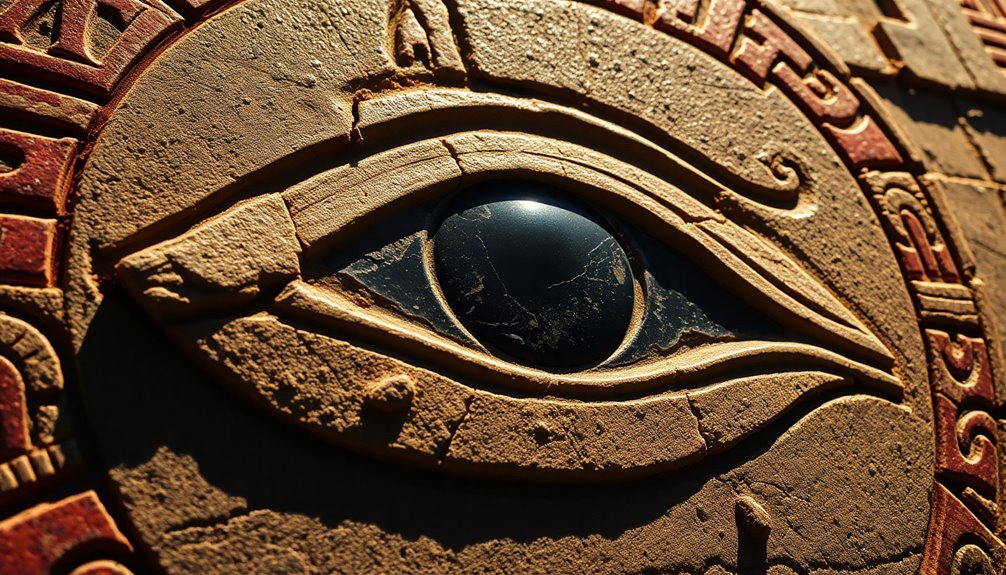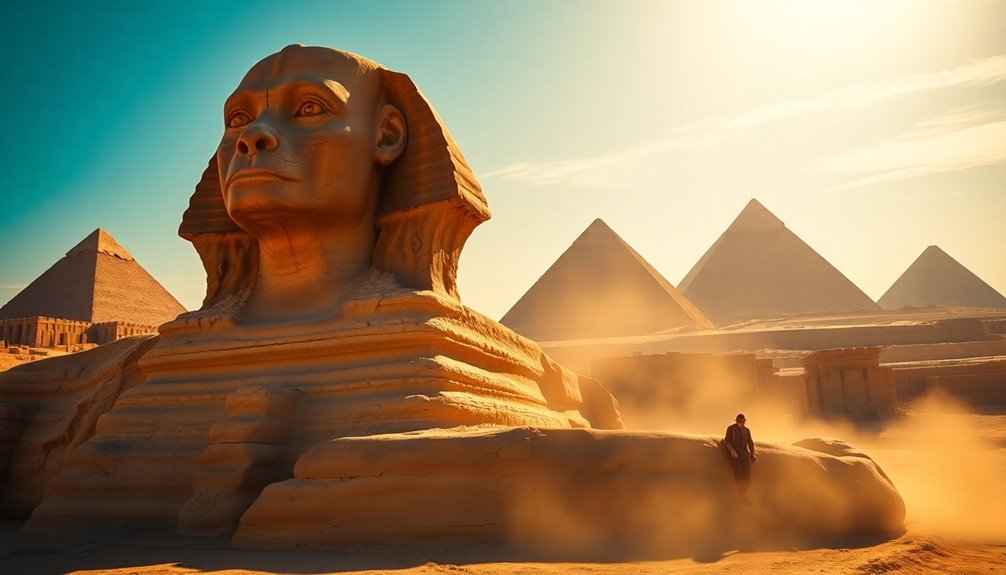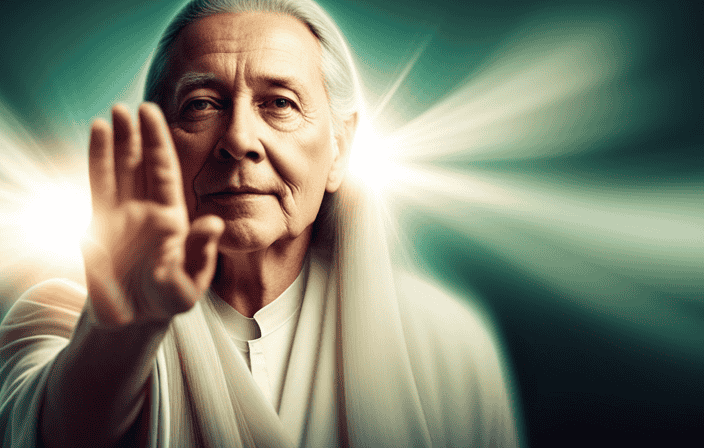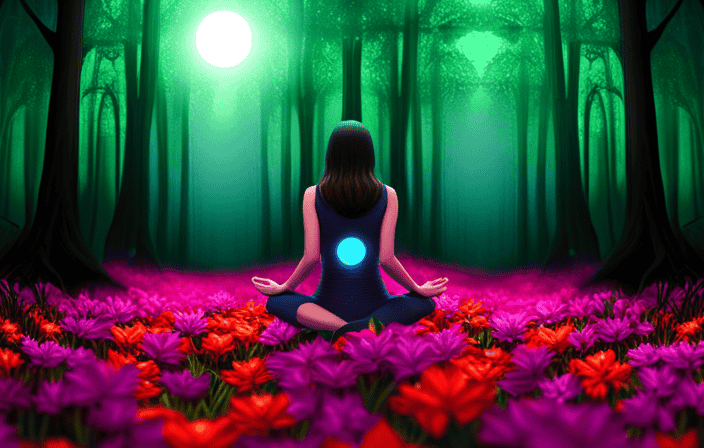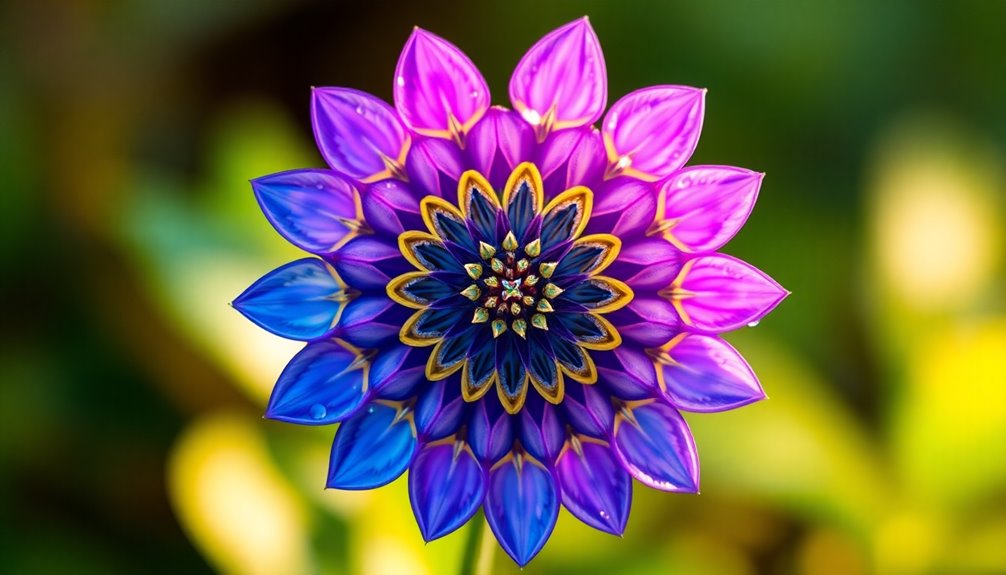The Eye of Ra isn't evil; it embodies a duality of protection and punishment in ancient Egyptian mythology. You'll find it serves to ward off malevolent forces and offers safety to followers, often appearing in temples. While it acts as a vigilant protector, it can also transform into a fierce avenger when justice demands it. This balance between nurturing and devastation reflects an intricate moral compass in Egyptian beliefs. So, while the Eye signifies protection, it's also a reminder of the consequences of wrongdoing. Want to uncover more about its layered significance and influence? Keep exploring!
Key Takeaways
- The Eye of Ra symbolizes protection and vigilance, not evil, serving to ward off malevolent forces in ancient Egyptian belief.
- It embodies duality as both protector and punisher, reflecting justice rather than inherent malevolence.
- Unlike the Evil Eye, which represents envy and malice, the Eye of Ra actively safeguards against chaos and harm.
- Rooted in ancient mythology, the Eye of Ra signifies divine authority and cosmic order rather than any notion of evil.
- Its cultural significance emphasizes nurturing and balance, highlighting its role in promoting righteousness rather than embodying evil.
Overview of the Eye of Ra
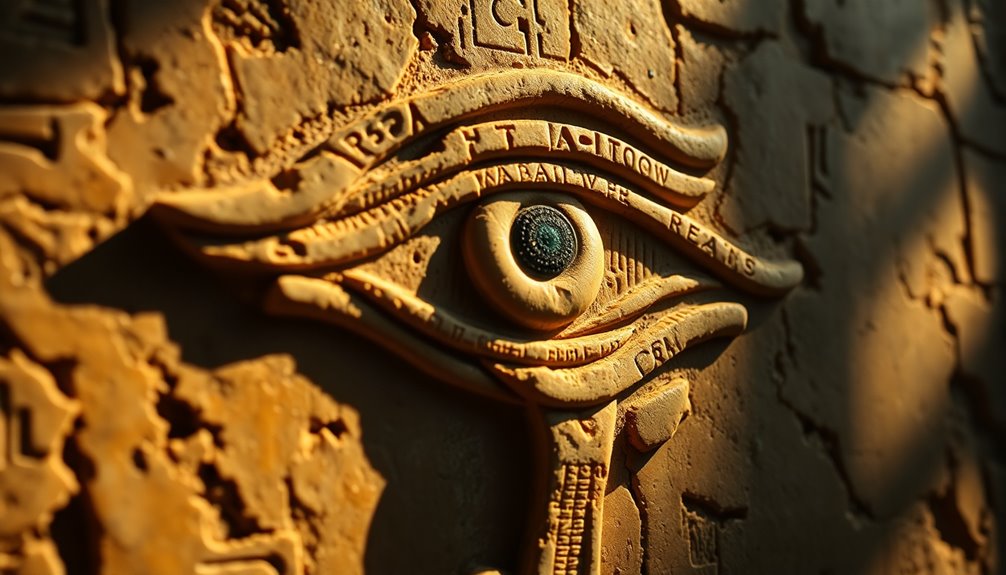
The Eye of Ra, an ancient Egyptian symbol, captivates with its rich meanings and powerful associations. This emblem, often depicted as a human eye with a teardrop, illustrates Ra's multifaceted relationships, including those with goddesses like Hathor, Sekhmet, and Bastet.
Its protective nature serves to ward off evil, ensuring safety for followers. You'll notice the Eye of Ra often placed above doorways in temples, signifying watchfulness and vigilance.
Myths surrounding the Eye reveal its duality, showcasing its nurturing aspects while also hinting at its destructive power. The teardrop represents fertility and rebirth, symbolizing Ra's tears as the origin of humanity's creation when he reunited with his children.
This dual nature reflects the balance of power inherent in Egyptian mythology, where the Eye of Ra embodies both the life-giving and the fearsome qualities of the sun.
Symbolism and Meaning
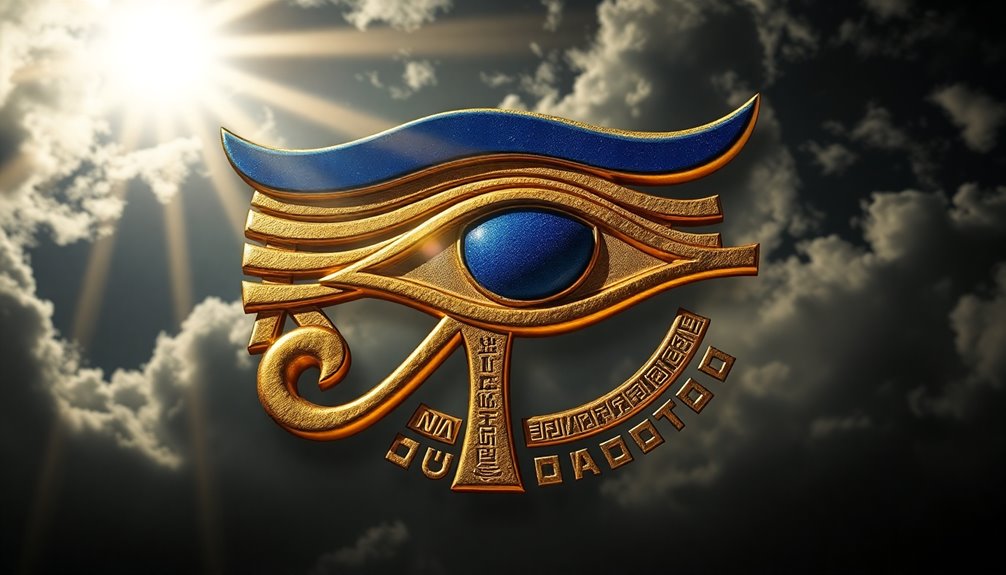
The Eye of Ra embodies a powerful duality, serving as both a protector and a punisher.
As a symbol of justice, it reflects the consequences of one's actions, reminding you of the balance between good and evil.
Understanding this complexity offers deeper insight into its role in ancient Egyptian belief systems.
Protective Functions of Ra
Symbolizing unwavering vigilance, the Eye of Ra serves as a powerful emblem of protection in ancient Egyptian mythology. This symbol embodies Ra's watchful gaze, warding off evil and ensuring the safety of his people. Frequently depicted above doorways in temples, the Eye signifies vigilance and acts as a warning against wrongdoing, punishing evildoers.
As a solar symbol, the Eye of Ra captures the duality of protection and aggression, reflecting both nurturing aspects and the destructive power of the sun. It's essential to royal authority, often paired with the crook and flail to signify the pharaoh's divine right to rule and maintain order.
In funerary texts, the Eye of Ra plays a vital role in protecting deceased souls during their journey through the afterlife, safeguarding them against chaos and evil.
Here's a quick overview of its protective functions:
| Function | Description |
|---|---|
| Warding off Evil | Protects people from malevolent forces |
| Symbol of Vigilance | Represents constant watchfulness |
| Royal Authority | Signifies the pharaoh's right to govern |
| Afterlife Protection | Safeguards souls from chaos in the afterlife |
| Nurturing Aspects | Balances aggression with care and sustenance |
Symbol of Justice
In ancient Egyptian culture, the Eye of Ra stands as a powerful symbol of justice, embodying the sun god Ra's authority over truth and morality. This emblem is more than just a decorative motif; it serves as a moral compass for society, guiding individuals toward righteousness while warding off evil deeds.
Here are three key aspects of the Eye of Ra as a symbol of justice:
- Vigilant Protector: The Eye is often depicted above doorways in temples, watching over the actions of individuals and punishing wrongdoers.
- Royal Authority: Associated with the crook and flail, the Eye of Ra emphasizes the connection between justice and governance, reinforcing the authority of leaders.
- Warding Off Evil: Unlike the broader concept of the Evil Eye, the Eye of Ra specifically targets malevolent actions, ensuring safety and order within the community.
Through its representation of protection and moral oversight, the Eye of Ra exemplifies Ra's enduring influence in maintaining justice and righting wrongs in ancient Egyptian society. Additionally, the concept of subconscious power during sleep can be linked to the Eye of Ra's ability to guide individuals towards their highest moral path.
Dual Nature of Power
Power wields a dual nature, especially when it comes to the Eye of Ra. In Egyptian mythology, this symbol embodies both protection and destruction, showcasing the complex dynamics of the sun's power.
On one hand, the Eye of Ra represents benevolence, acting as a nurturing force that seeks to protect and sustain life. Myths often depict it searching for Ra's lost children, illustrating its role in creation and regeneration.
On the flip side, the Eye also manifests ferocity, demonstrating its capacity for retribution. In tales where it transforms into Sekhmet, the Eye punishes humanity for its wrongdoings, emphasizing the destructive aspect of its power.
This duality is vital for maintaining cosmic order, as it balances justice with mercy. The Eye of Ra can see all, ensuring that truth prevails while administering punishment to those who stray from righteousness.
Ultimately, understanding this dual nature is significant. The Eye of Ra isn't merely a symbol of evil; it embodies the intricate relationship between protection and destruction, revealing how power can both nurture and devastate within the grand tapestry of existence.
Mythological Context

The Eye of Ra serves as a fascinating symbol within Egyptian mythology, embodying both nurturing and destructive forces. It represents the duality of life, where creation and chaos coexist. Here are three key aspects to reflect on:
- Destructive Aspects: The Eye of Ra can release vengeance, especially when Ra feels betrayed.
- Transformation into Sekhmet: In one myth, the Eye transforms into Sekhmet, the lioness goddess, to punish humanity, showcasing the eye's aggressive nature linked to the sun's harshness.
- Independent Entity: The Eye of Ra operates as an independent entity, involved in creation and tasked with retrieving Ra's lost children.
These narratives highlight the Eye's complex role in Egyptian cosmology. It's not merely a symbol of destruction; it also embodies regeneration.
Myths illustrate how the Eye of Ra's rampages against humanity are crucial for the natural cycles essential to life. In addition, the connection between the Eye of Ra and the Eye of Horus further emphasizes the balance of chaos and order.
This intricate interplay underscores the Eye's significance in understanding the broader themes within Egyptian mythology.
Cultural Significance

Throughout ancient Egyptian culture, the Eye of Ra emerged as an essential symbol of protection and authority. You'll find it depicted in temples and art, serving as a guardian against chaos and malevolent forces. This powerful emblem reflects the duality present in Egyptian mythology, embodying both nurturing and destructive powers, vital to understanding life and death.
To grasp its cultural significance, consider the following table:
| Aspect | Description |
|---|---|
| Symbol of Protection | Wards off evil and guarantees safety for the people and the pharaoh. |
| Association with Authority | Represents royal power, reinforcing the pharaoh's divine right to rule. |
| Duality | Balances nurturing aspects with destructive capabilities, illustrating life's complexities. |
| Connection to the Ankh | Reinforces themes of life and immortality, emphasizing the cyclical nature of existence. |
Temples like the Temple of Sekhmet at Karnak highlight the enduring reverence for the Eye of Ra. Its presence in ancient Egyptian culture illustrates how central it was to the belief systems that shaped daily life and spiritual practices. Understanding this symbol deepens your appreciation for its multifaceted role throughout history.
Modern Worship Practices
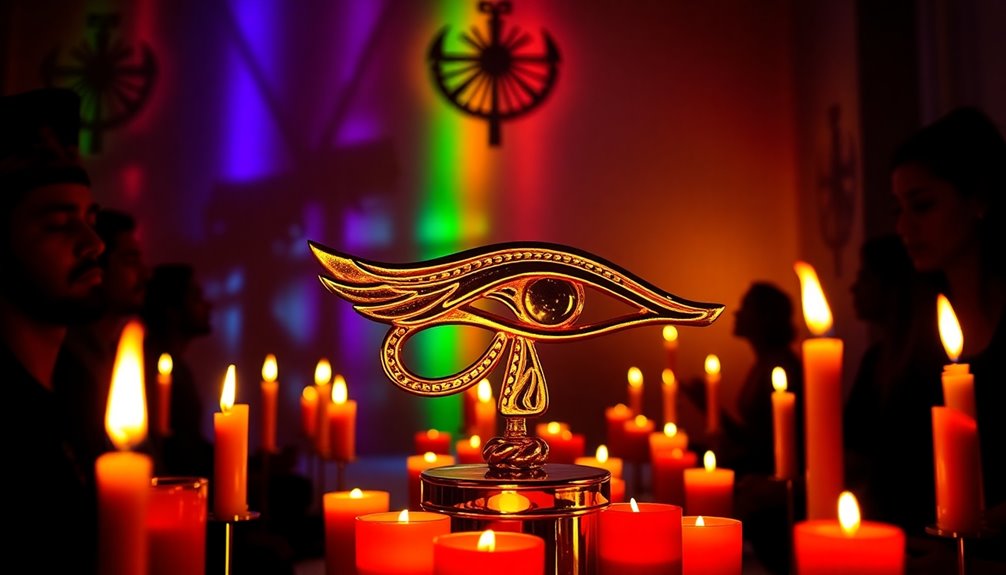
In today's world, you'll find that modern worship of the Eye of Ra often includes vibrant rituals and celebrations that honor its protective qualities.
Many devotees incorporate symbolic art and iconography, such as amulets and jewelry, to connect with these ancient beliefs.
Contemporary Rituals and Celebrations
Modern worship practices centered around the Eye of Ra have really taken off, blending ancient traditions with contemporary celebrations.
Today, you'll find various contemporary rituals that honor the Eye of Ra, often emphasizing its themes of protection, health, and harmony in daily life.
Here are three key aspects of modern celebrations:
- Festivals: Annual events celebrate deities linked to the Eye, such as Mut and Sekhmet, featuring communal activities like drinking, dancing, and theatrical performances.
- Temple Gatherings: Places like the Temple of Sekhmet at Karnak and the Temple of Hathor at Dendera continue to draw worshippers and tourists, showcasing a lasting reverence for the Eye of Ra.
- Personal Amulets: Many modern worshippers create amulets incorporating the Eye of Ra, believing they offer protection against chaos and evil, reinforcing its significance in contemporary spirituality.
These rituals reflect a deep connection to the past while adapting to current spiritual needs, emphasizing the Eye of Ra's role in fostering harmony and safeguarding against life's challenges.
Symbolic Art and Iconography
Artists frequently draw inspiration from the Eye of Ra in their work, creating pieces that resonate with its rich symbolism. This powerful icon embodies protection and chaos, reflecting its ancient significance while adapting to modern interpretations.
You'll find the Eye of Ra prominently featured in symbolic art, often combined with other motifs like the ankh, which emphasizes themes of life and immortality.
In contemporary worship practices, the Eye of Ra appears in amulets and talismans, believed to provide protection against evil and promote good health. This connection to the divine showcases its enduring cultural relevance.
Temples dedicated to the Eye of Ra, such as the Temple of Sekhmet at Karnak, attract visitors and serve as sites for modern rituals, celebrating the icon's nurturing force.
Moreover, artists explore the dual nature of the Eye of Ra, balancing its roles as a protector and a punisher. This complexity invites you to reflect on the deeper meanings behind the imagery.
Ultimately, the Eye of Ra in symbolic art and iconography continues to inspire and provoke thought, bridging the ancient and modern worlds.
Distinctions From the Evil Eye
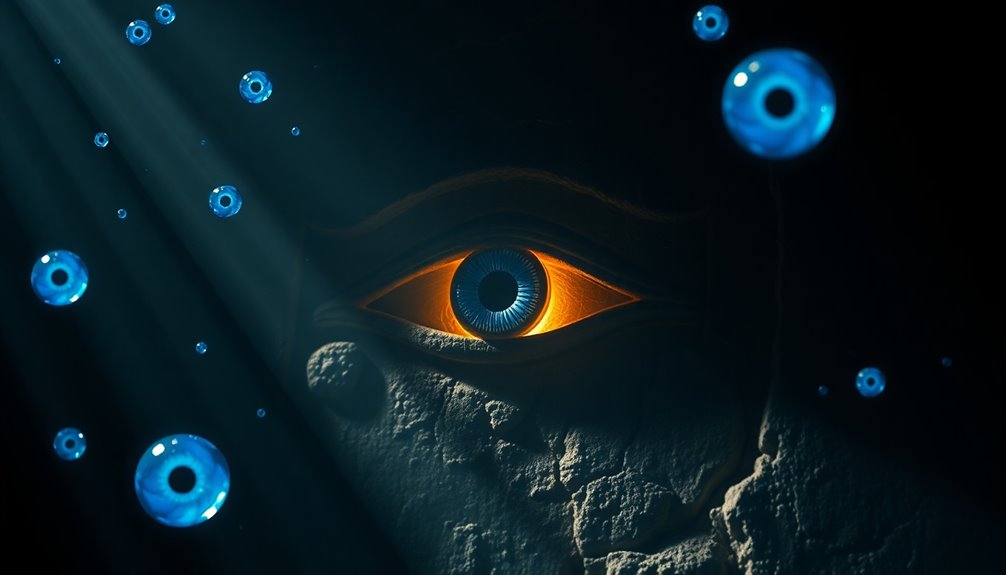
Though often mistaken for one another, the Eye of Ra and the Evil Eye possess distinct origins and meanings that set them apart. Here are three key distinctions:
1. Origins: The Eye of Ra is rooted in ancient Egyptian mythology, symbolizing protection and the sun's destructive power.
In contrast, the Evil Eye stems from Turkish and broader cultural traditions, representing envy and malice.
2. Function: The Eye of Ra acts as a guardian against chaos and evil, actively warding off malevolent forces.
On the other hand, the Evil Eye is viewed as a passive threat, capable of unintentionally causing harm to those who receive it.
3. Cultural Significance: The Eye of Ra is integral to royal authority and often depicted alongside symbols of power, celebrating its protective role in ancient Egyptian rituals.
Conversely, the Evil Eye serves as a warning against jealousy, countered with protective amulets and rituals aimed at neutralizing its negative effects.
Understanding these distinctions clarifies why the Eye of Ra shouldn't be conflated with the Evil Eye; their meanings and roles in their respective cultures are fundamentally different.
Frequently Asked Questions
Is The Eye of Ra Real?
The Eye of Ra isn't real in a physical sense, but it holds immense cultural and symbolic significance in ancient Egyptian mythology.
You'll find it depicted in art and artifacts, representing the sun god's power and protection. It symbolizes duality—nurturing and destructive forces.
While it doesn't exist as a tangible object, its influence on ancient beliefs and practices is very real, showcasing the profound connection between mythology and culture.
Is the Eye of Ra Evil in the Bible?
When you immerse yourself in the biblical narrative, you'll find the Eye of Ra tangled in a web of negativity.
While it's not explicitly labeled as evil, its association with Egyptian deities highlights a stark contrast to the power of the God of Israel.
The plagues serve as a reminder of Ra's impotence, casting shadows on his once-mighty image.
What Is the True Story of Ra?
The true story of Ra unfolds as you explore ancient Egyptian mythology.
Ra, the powerful sun god, creates humanity from his tears, showcasing his nurturing side. His eye acts as both protector and avenger, searching for his lost children, Tefnut and Shu.
When angered, it punishes humanity, reflecting his dual nature. Ultimately, his story reveals the balance between creation and destruction, emphasizing the complexities of divine influence in human affairs.
What Happened to Ra's Eye?
When it comes to Ra's eye, you've got to understand its dual nature.
Initially sent to find Ra's lost children, Shu and Tefnut, it returned in anger, causing chaos among humans. This fierce guardian, often represented by Sekhmet, symbolizes both destruction and protection.
After feeling betrayed, it transformed into the uraeus, embodying a complex relationship with humanity, balancing nurturing and punishment as it reflects the harsh realities of life and the cosmos.
Conclusion
In exploring the Eye of Ra, you see it's not just a symbol of evil but a powerful emblem of protection and strength. Imagine a mother, wearing an amulet adorned with the Eye, feeling a sense of reassurance as her child plays outside. Rather than invoking fear, it connects her to a rich cultural legacy, reminding us that symbols can carry multiple meanings. Ultimately, the Eye of Ra invites you to embrace its deeper, more nuanced significance.
